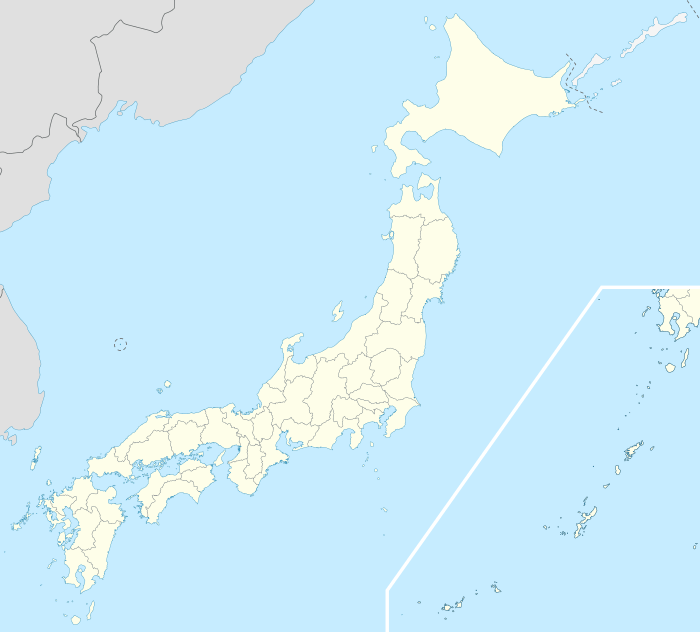Komae, Tokyo
| Komae 狛江市 | ||
|---|---|---|
| City | ||
| ||
 Location of Komae in Tokyo Metropolis | ||
 Komae Location in Japan | ||
| Coordinates: 35°38′N 139°35′E / 35.633°N 139.583°ECoordinates: 35°38′N 139°35′E / 35.633°N 139.583°E | ||
| Country | Japan | |
| Region | Kantō | |
| Prefecture | Tokyo Metropolis | |
| Government | ||
| • Mayor | Yutaka Yano | |
| Area | ||
| • Total | 6.39 km2 (2.47 sq mi) | |
| Population (2006) | ||
| • Total | 78,368 | |
| • Density | 12,159/km2 (31,490/sq mi) | |
| Time zone | Japan Standard Time (UTC+9) | |
| Symbols | ||
| - Tree | Ginkgo | |
| - Flower | Azalea | |
| Phone number | 03-3430-1111 | |
| Website | Komae City | |
Komae (狛江市 Komae-shi) is a municipality administered as a city, located in Tokyo Metropolis, Japan. It is one of 30 municipalities in the western portion of Tokyo-to known as the Tama Area.
As of September 1, 2008, the city has an estimated population of 76,952. The total area is 6.39 km². It is the smallest administrative city in Tokyo both in area and population. Its population density of 12,159 persons per km² makes it the third most densely populated municipality in Japan outside the 23 central wards of Tokyo.
History
The administrative boundaries of the farming village of Komae was founded in 1889. In 1893, it was transferred from Kanagawa Prefecture to Tokyo Prefecture. Odakyu Railways's Odawara line was constructed through Komae in 1926, linking it with Shinjuku in central Tokyo. Expanding population led to Komae being upgraded to the status of a town in 1952, and to a city on October 1, 1970.
On September 1, 1970, Tama River's levee failed during a typhoon, and 19 houses were destroyed by torrential flooding. The riverbanks have now been strengthened. A small memorial stands at the location of the levee failure.
Politics and government
Komae is run by a city assembly of 22 elected members. The current mayor is Yutaka Yano, an independent affiliated with the Japanese Communist Party. The JCP is also the largest party in the assembly and forms a majority together with several smaller parties.
In the mayoral election held on June 22, 2008, Yutaka Yano defeated two independent opponents, supported by the Liberal Democratic Party and Democratic Party of Japan, to win a fourth term.
Geography

Komae is nestled between the Tama River to the southwest, and the much smaller Nogawa river to the north and east which flows near its boundaries with Chōfu city and Setagaya Ward. It is mostly flat. It is a small municipality; its boundaries fit within a circle of 2 km radius centred on the city hall. It is essentially a residential suburb of Tokyo which urbanised rapidly in the 1960s and 1970s, with most of the working population commuting to central Tokyo. There are several neighbourhood shopping areas, mainly around the train stations. The City Hall is located near Komae Station.
Rail access in and out of the city is mainly via Komae, Kitami and Izumi-Tamagawa stations, all of them minor stops on the Odakyu Odawara Line. Some areas in the north of the city have better access to Keiō Line stations in neighbouring Chōfu city.
Education
Komae operates public elementary and junior high schools.
Tokyo Metropolitan Government Board of Education operates Komae High School.
Others
The town has a group of festival mascots called Komarangers; their purpose is to cheer up the citizens of the town. They come in five colors: red, blue, green, yellow, and pink.
Along with several Japanese actors, the following are from Komae:
- Sadao Araki - a leading pre-war rightwing politician, convicted Class A war criminal.
- Sumire Haruno - the former top star for the Flower Troupe of the Takarazuka Revue.
Annual events in Komae include a raft-race on Tama River every July, and a city fair in mid-November.
Komae is home to six local Shinto shrines and four local Buddhist temples, all of them minor.
The city's name is thought to originate from the word koma, referring to migrants, especially Goguryeo from the Korean peninsula who settled here more than 1000 years ago.[1][2][3]
References
- ↑ Sumiko Enbutsu; Mimi LeBourgeois (April 2000). "Tokyo Water Walks". Tokyo On Foot hosted by Tokyoq.
The city name, Komae, probably derived from "Koma," a word referring to Kogyo of ancient Korea, probable origin of the immigrants.
- ↑ 東京都狛江市歴史探訪 (in Japanese).
狛江の名前の由来> 古来、高麗人が日本の関東地方に帰化しましたが、狛江の地にも人々が渡来しました。このことから、地名の由来は「高麗(コマ)」に由来しているといわれています。
- ↑ Ayako Shinomiya Burton (November 1994). "Japanese Language Planning in Korea 1905-1945" (PDF). Simon Fraser University. pp. 11p.
particularly around the 5th century, as many Koreans technically skilled in such areas as architecture, ceramics, weaving and iron casting camed to and settled in Japan. Korean cultrual words such as fude (writing brush), tefu (notebook), and even place names such as Koma, Komae and Rebonri, and the most prominent, Nara ("country" in Korea), were introduced into Japan around that time.
External links
![]() Media related to Komae, Tokyo at Wikimedia Commons
Media related to Komae, Tokyo at Wikimedia Commons
- Komae City official website (Japanese)
| ||||||||||||||||||||||||||
